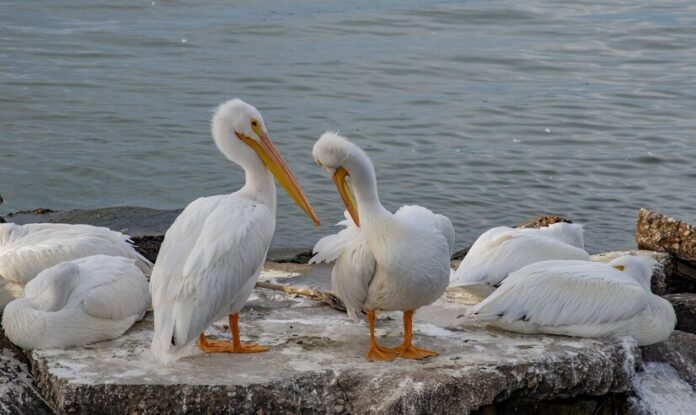Pelicans are some of the most recognizable and fascinating birds within the avian world. Known for their big, exclusive payments and mind-blowing wingspans, those birds have involved observers and scientists alike. This article delves into the existence, habitat, behavior, and conservation of pelicans, dropping mild on why they’re such excellent creatures.
Overview of Pelicans
Pelicans belong to the own family Pelecanidae, which incorporates eight wonderful species spread across numerous continents. These huge water birds are known for their long beaks equipped with a unique, expandable pouch that performs a important role of their feeding method. Pelicans are discovered in various habitats, which includes coastal regions, inland lakes, and rivers.
Species of Pelicans
- American White Pelican (Pelecanus erythrorhynchos): Found in North America, this species is extraordinary for its hanging white plumage and black wing tips. They usually inhabit large, shallow lakes and marshes.
- Brown Pelican (Pelecanus occidentalis): Distinguished by way of its brown plumage and a lighter-colored head, the Brown Pelican is commonly found alongside the coasts of the Americas. It is thought for its dramatic diving looking method.
- Dalmatian Pelican (Pelecanus crispus): Native to southeastern Europe and Asia, the Dalmatian Pelican is identified by its huge length and distinct, curly feathers. It inhabits freshwater lakes and rivers.
- Great White Pelican (Pelecanus onocrotalus): With its widespread range throughout Europe, Africa, and Asia, the Great White Pelican is tremendous for its large size and faded plumage. It is often seen in big colonies on freshwater bodies.
- Pink-sponsored Pelican (Pelecanus rufescens): Found in Africa, the Pink-sponsored Pelican has a distinctive pinkish hue on its again and is usually seen in shallow freshwater habitats.
Physical Characteristics
Pelicans are regarded for his or her wonderful physical capabilities, which include:
- Large Bill: Their most special characteristic, the invoice, is lengthy and ready with a deep pouch. This pouch is used to scoop up fish and different prey from the water.
- Wingspan: Pelicans have broad wings and large wingspans, which could exceed 9 ft in some species. This version enables them flow resultseasily over water and cowl big distances looking for meals.
- Webbed Feet: Their webbed ft are adapted for swimming and maneuvering thru water, making them effective hunters and swimmers.
Feeding and Hunting
Pelicans are commonly piscivorous, meaning their weight loss program is composed especially of fish. Their feeding approach varies among species, but usually includes some key methods:

- Surface-Dipping: Some pelicans, like the Brown Pelican, use a floor-dipping technique where they dive from the air into the water to catch fish. This dramatic hunting technique is both effective and visually placing.
- Group Fishing: Many pelican species, together with the American White Pelican, have interaction in cooperative fishing. They form groups and pressure fish into shallow waters wherein they are easier to capture. This social searching behavior enhances their efficiency in finding food.
- Pouch Fishing: Pelicans use their big, expandable pouches to scoop up fish and water. After catching their prey, they drain the water from the pouch before swallowing the fish.
Habitat and Range
Pelicans are surprisingly adaptable and may be discovered in a number of aquatic environments. Their habitats consist of:
- Coastal Areas: Many pelicans stay alongside coastlines in which they have got get admission to to abundant fish. They are regularly seen on sandy beaches, rocky shorelines, and estuaries.
- Freshwater Lakes and Rivers: Species just like the Great White Pelican and the Dalmatian Pelican choose freshwater environments. They are usually found in massive lakes, wetlands, and rivers.
- Marshes and Swamps: Shallow, vegetated wetlands are perfect for pelicans, presenting adequate feeding opportunities and secure nesting web sites.
Breeding and Nesting
Pelican breeding conduct vary between species, however they normally involve the subsequent:
- Nesting Colonies: Pelicans are recognized for nesting in colonies, that could encompass dozens to hundreds of pairs. These colonies are frequently placed on isolated islands or in included regions to reduce the risk of predation.
- Nest Construction: Nests are commonly constructed at the ground or in low plants. They are constructed from numerous materials, which includes sticks, reeds, and grasses.
- Eggs and Chicks: Pelicans generally lay two to a few eggs in step with take hold of. Both mother and father take turns incubating the eggs and feeding the chicks once they hatch. The chicks are altricial, which means they’re born helpless and require widespread care from their mother and father.
Conservation Status
Pelicans face numerous conservation challenges, which include habitat loss, pollution, and climate trade. Some species are considered to be of problem because of declining populations and threats to their habitats.
Threats to Pelicans
- Habitat Destruction: Coastal improvement, deforestation, and wetland drainage threaten pelican habitats, reducing their get admission to to feeding and nesting web sites.
- Pollution: Chemical pollutants, including pesticides and heavy metals, can contaminate water assets and damage pelicans directly or circuitously via the food chain.
- Climate Change: Changes in temperature and sea degrees can have an effect on pelican breeding and feeding styles, doubtlessly leading to decreased reproductive fulfillment and habitat loss.
Conservation Efforts
To cope with those demanding situations, various conservation tasks are in vicinity:
- Protected Areas: Establishing and keeping covered regions for pelicans enables shield essential habitats and breeding web sites.
- Pollution Control: Efforts to reduce pollution and manipulate waste can help enhance water exceptional and guard pelican populations.
- Climate Change Mitigation: Addressing weather alternate thru global and neighborhood projects can assist lessen its effect on pelican habitats and populations.
Cultural Significance
Pelicans have also performed a function in numerous cultures and traditions. They are frequently featured in folklore, art, and symbolism, representing qualities inclusive of resourcefulness, cooperation, and resilience. In a few cultures, pelicans are visible as symbols of abundance and nurturing.



